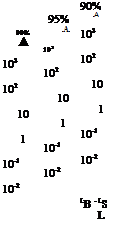The most important factors that determine the efficiency of the sense of sight are:
1. Luminance Discrimination—The ability to distinguish differences and variations in brightness.
2. Sharpness—The ability to define and differentiate shapes.
3. Temporal Visual Ability—The ability to distinguish changes and movements over time.
4. Depth Discrimination—The ability to judge depth (variation in image between the two eyes).
5. Colour Discrimination—The ability to discriminate the wavelength of
the light.
The first factor is thought to be the most important. The ability to discriminate brightness is usually expressed as contrast sensitivity. Contrast can be expressed by the following formula:
where LB stands for the brightness of the background (luminance) and Ls for the luminance of the signal or object that is to be distinguished. Figure 10.1 shows how visual performance varies with contrast and background luminance. The visual
 |
|
 |
|
Numbers of Recognizable Variations of Different Stimuli
|
TABLE 10.3
|
FIGuRE 10.1 The relationship between contrast for different performance levels on the vertical axis (95% is taken to be sufficiently good for most tasks) and luminance on the horizontal axis. The range of curves is shown for different exposure times and sizes of visual target.
efficiency is normally directly related to the lighting intensity and the luminance of the background and surrounding surfaces. It can be seen from Figure 10.1 that for a given contrast (for example, K = 0.1), the lighting level must be increased, which also directly increases background luminance, if performance is to be improved. This is because, among other things, increased intensity of light gives increased sharpness of vision.
The requirement of sharpness of vision can be reduced by increasing the size of the critical parts of the visual task. For small objects or dim lighting, recognition speed (temporal visual ability) may be reduced if the light levels are increased. In order to get good visual conditions, it is better to increase the size and contrast of the object rather than increasing the lighting level. If it is necessary to increase the light level, problems of glare must be taken into account. In particular, one must take care to avoid reflections on panels and instrument glasses.
The sensitivity of the eyes changes (adapts) to the average luminance of those surfaces to which they are exposed. The adaptation that the sense of sight carries out means that humans do not experience the luminance of different surfaces in the same way as a light meter. The latter measures only the physical intensity of the luminance. The human eye reacts differently. If, for example, it is adapted for a very low level of luminance and lighting (such as a very large opening of the pupil and very sensitive retina), a surface with a relatively low luminance (but higher than the very low adaptation luminance) is perceived as being very bright. If, on the other hand, the adaptation luminance is very high (for example, due to sitting and looking at a bright sky), even surfaces with relatively high luminances will appear to be dark. These relationships are illustrated in Figure 10.2.
In order to work in the dark, total dark adaptation can be achieved if sufficient time is spent in a dark place. This may occur in certain types of control rooms, for example, on board ships, in certain types of traffic monitoring, and other situations where radar screens are used. In practice, this means that the light sensitivity of the eye increases considerably, and a certain level of visual ability can be maintained despite the darkness. However, it takes up to thirty minutes for dark adaptation to be fully achieved.
|
FIGURE 10.2 Relationships between perceived luminance, true luminance, and adaptation luminance. (After Hopkinson and Collins, 1970. With permission.) |
It is important that such areas are sufficiently dark and the eye must not be exposed to any direct light. Only red light can be tolerated. The visual acuity (sharpness) is very much reduced when the eye is dark-adapted. This means that only large objects can be seen. Direct reading of small details on instruments in the dark requires the use of special equipment. Certain recommendations on the design of such control rooms are given in Chapter 5.




